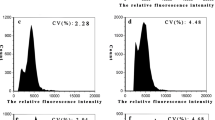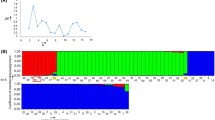Abstract
Erianthus arundinaceus, part of the Saccharum complex, is increasingly important as a bioenergy crop and a potential resource for sugarcane improvement. Germplasm is widely distributed in the tropical zone in Southeast Asia and southern China, and has been found in the subtropical and temperate zones in Japan. Here, we investigated the 2C DNA content and simple sequence repeat (SSR) polymorphisms in E. arundinaceus accessions native to Japan. To estimate DNA content, flow cytometric analysis was performed on accessions collected from three climatic zones (temperate, subtropical, and tropical) in Japan and Indonesia. DNA content ranged from 7.42 to 8.10 pg (mean 7.62 pg), and all examined accessions fell into two groups reflecting collection location: the temperate zone in Japan (mean 8.06 pg) and the subtropical and tropical zones in Japan and Indonesia (mean 7.56 pg). Although DNA content differed significantly between the accessions from temperate and tropical/subtropical zones, chromosome number was inferred to be identical in all accessions. A phylogenetic tree of 42 accessions in the Saccharum complex based on detected fragments from 31 SSR primer pairs classified Erianthus and related genera into well-defined distinct groups. Thus, both 2C DNA content and phylogenetic analysis subdivided the E. arundinaceus accessions into two groups, suggesting that some of the Japanese accessions had different genetic characteristics from other accessions from Japan and Indonesia.



Similar content being viewed by others
References
Amalraj VA, Balasundaram N (2006) On the taxonomy of the members of ‘Saccharum complex’. Genet Resour Crop Evol 53:35–41. doi:10.1007/s10722-004-0581-1
Ando S, Sugiura M, Yamada T, Katsuta M, Ishikawa S, Terajima Y, Sugimoto A, Matsuoka M (2011) Overwintering ability and dry matter production of sugarcane hybrids and relatives in the Kanto region of Japan. JARQ 45:259–267. doi:10.6090/jarq.45.259
Bennett MD, Bhandol P, Leitch IJ (2000) Nuclear DNA amounts in angiosperms and their modern uses—807 new estimates. Ann Bot 86:859–909. doi:10.1006/anbo.2000.1253
Berding N, Roach BT (1987) Germplasm collection, maintenance, and use. In: Heinz DJ (ed) Sugarcane improvement through breeding. Elsevier press, Amsterdam, pp 143–210
Besse P, Mcintyre CL, Berding N (1996) Ribosomal DNA variation in Erianthus, a wild sugarcane relative (Andropogoneae-Saccharinae). Theor Appl Genet 92:733–743. doi:10.1007/BF00226096
Besse P, McIntyre CL, Berding N (1997) Characterisation of Erianthus sect Ripidium and Saccharum germplasm (Andropogoneae-Saccharinae) using RFLP markers. Euphytica 93:283–292. doi:10.1023/A:1002940701171
Cai Q, Aitken KS, Fan YH, Piperidis G, Liu XL, McIntyre CL, Huang XQ, Jackson P (2012) Assessment of the genetic diversity in a collection of Erianthus arundinaceus. Genet Resour Crop Evol 59:1483–1491. doi:10.1007/s10722-011-9776-4
Costich DE, Friebe B, Sheehan MJ, Casler MD, Buckler ES (2010) Genome-size variation in switchgrass (Panicum virgatum): flow cytometry and cytology reveal rampant aneuploidy. Plant Genome 3:130–141. doi:10.3835/plantgenome2010.04.0010
Doležel J, Bartoš J (2005) Plant DNA flow cytometry and estimation of nuclear genome size. Ann Bot 95:99–110. doi:10.1093/aob/mci005
Doležel J, Greihuber J, Suda J (2007) Estimation of nuclear DNA content in plants using flow cytometry. Nat Protocol 2:2233–2244. doi:10.1038/nprot.2007.310
Ebina M, Tsuruta S, Kobayashi M, Terajima Y, Irei S (2016) A development of SSR linkage map of Erianthus, wild relatives of Saccharum, for breeding improvement of sugar cane. Abstract of Plant & Animal Genome Conference XXIV. https://pag.confex.com/pag/xxiv/webprogram/Paper19596.html. Accessed 30 Jan 2016
Fukuhara S, Terajima Y, Irei S, Sakaigaichi T, Ujihara K, Sugimoto A, Matsuoka M (2013) Identification and characterization of intergeneric hybrid of commercial sugarcane (Saccharum spp. hybrid) and Erianthus arundinaceus (Retz.). Euphytica 189:321–327. doi:10.1007/s10681-012-0748-3
Goldemberg J (2007) Ethanol for a sustainable energy future. Science 315:808–810. doi:10.1126/science.1137013
Goldman JJ (2015) DNA contents in Texas bluegrass (Poa arachnifera) selected in Texas and Oklahoma determined by flow cytometry. Genet Resour Crop Evol 62:643–647. doi:10.1007/s10722-015-0247-1
Hampl V, Pavlícek A, Flegr J (2001) Construction and bootstrap analysis of DNA fingerprinting-based phylogenetic trees with the freeware program Freetree: application to trichomonad parasites. Int J Syst Evol Microbiol 51:731–735. doi:10.1099/00207713-51-3-731
Irei S, Fukuhara S, Terajima Y, Sakaigaichi T, Matsuoka M, Sugimoto A (2008) Exploration and collection of sugarcane wild species (Erianthus spp.) in Okinawa island. Ann Rep Explor Introd Plant Genet Resour 24:47–53 (Japanese with English summary)
Jaccard P (1908) Nouvelles recherches sur la distribution florale. Bull Soc Vaud Sci Nat 44:223–270. doi:10.5169/seals-268384
Jackson P, Henry RJ (2011) Erianthus. In: Kole C (ed) Wild crop relatives: genomic and breeding resources: industrial crops. Springer, Berlin, pp 97–107. doi:10.1007/978-3-642-21102-7_5
Kashkush K, Feldman M, Levy AA (2002) Gene loss, silencing and activation in a newly synthesized wheat allotetraploid. Genetics 160:1651–1659
Kashkush K, Feldman M, Levy AA (2003) Transcriptional activation of retrotransposons alters the expression of adjacent genes in wheat. Nat Genet 33:102–106. doi:10.1038/ng1063
Kim C, Wang X, Lee T-H, Jakob K, Lee G-J, Paterson AH (2014) Comparative analysis of Miscanthus and Saccharum reveals a shared whole-genome duplication but different evolutionary fates. Plant Cell 26:2420–2429. doi:10.1105/tpc.114.125583
Kobayashi M (2009) Outline of biomass gasification methanol synthesis and vision of perennial grasses for biomass feedstock. Jpn J Grassl Sci 55:284–287 (In Japanese)
Lee DJ, Berding N, Jackes BR, Bielig M (1998) Isozyme markers in Saccharum spp. hybrids and Erianthus arundinaceus (Retz) Jeswiet. Aust J Agric Res 49:915–921
Leitch IJ, Bennet MD (2004) Genome downsizing in polyploid plants. Biol J 82:651–663. doi:10.1111/j.1095-8312.2004.00349.x
Lowrance R, Anderson W, Miguez F, Strickland T, Knoll J, Sauer T (2010) Landscape management and sustainable feedstock production: enhancing net regional primary production while minimizing externalities. In: Braun R, Karlen D, Johnson D (eds) Sustainable feedstocks for advanced biofuels, Chapter 1. Soil and Water Conservation Society, Los Angeles, pp 1–19
Lysak MA, Doležel J (1998) Estimation of nuclear DNA content in Sesleria (Poaceae). Caryologia 5:123–132. doi:10.1080/00087114.1998.10589127
Mislevy P, Martin FG, Adjei MB, Miller JD (1997) Harvest management effects on quantity and quality of Erianthus plant morphological components. Biomass Bioenergy 13:51–58. doi:10.1016/S0961-9534(97)00023-8
Mueller SA, Anderson JE, Wallington TJ (2011) Impact of biofuel production and other supply and demand factors on food price increases in 2008. Biomass Bioenergy 35:1623–1632. doi:10.1016/j.biombioe.2011.01.030
Mukherjee SK (1957) Origin and distribution of Saccharum. Bot Gaz 119:55–61
Murray BG (2005) When does intraspecific C value variation become taxonomically significant? Ann Bot 95:119–125. doi:10.1093/aob/mci007
Murray MG, Thompson WF (1980) Rapid isolation of high molecular weight plant DNA. Nucleic Acids Res 8:4321–4326. doi:10.1093/nar/8.19.4321
Nair NV, Praneetha M (2006) Cyto-morphological studies on three Erianthus arundinaceus (Retz.) Jeswiet accessions from Andaman-Nicobar islands, India. Cytologia 71:107–109. doi:10.1508/cytologia.71.107
Nair NV, Selvi A, Sreenivasan TV, Pushpalatha KN, Mary S (2005) Molecular diversity among Saccharum, Erianthus, Sorghum, Zea and their hybrids. Sugar Tech 7:55–59. doi:10.1007/BF02942418
Nakagawa H, Sakai M, Harada T, Ichinose T, Takeno K, Matsumoto S, Kobayashi M, Matsumoto K, Yakushido K (2011) Biomethanol production from forage grasses, trees, and crop residues. In: dos Santos Bernardes MA (ed) Biofuel’s engineering process technology, Chapter 30. Rijeka, Croatia, pp 715–732. doi: 10.5772/18168
Ragauskas AJ, Williams CK, Davison BH, Britovsek G, Cairney J, Eckert CA, Frederick WJ Jr, Hallett JP, Leak DJ, Liotta CL, Mielenz JR, Murphy R, Templer R, Tschaplinski T (2006) The path forward for biofuels and biomaterials. Science 311:484–489. doi:10.1126/science.1114736
Roldán-Ruiz I, Dendauw J, van Bockstaele E, Depicker A, Loose M (2000) AFLP markers reveal high polymorphic rates in ryegrasses (Lolium spp.). Mol Breed 6:125–126. doi:10.1023/A:1009680614564
Saito N, Nei M (1987) The neighbor-joining method: a new method for reconstructing phylogenetic trees. Mol Biol Evol 4:406–425
Samson R, Mani S, Boddey R, Sokhansanj S, Quesada D, Urquiaga S, Reis V, Ho Lem C (2005) The potential of C4 perennial grasses for developing a global BIOHEAT industry. Crit Rev Plant Sci 24:461–495. doi:10.1080/07352680500316508
Saratale GD, Chen SD, Lo YC, Saratale RG, Chang JS (2008) Outlook of biohydrogen production from lignocellulosic feedstock using dark fermentation—a review. J Sci Ind Res 67:962–979
Schuelke M (2000) An economic method for the fluorescent labeling of PCR fragments. Nat Biotechnol 18:233–234. doi:10.1038/72708
Selvi A, Nair NV, Noyer JL, Singh NK, Balasundaram N, Bansal KC, Koundal KR, Mohapatra T (2006) AFLP analysis of the phenetic organization and genetic diversity in the sugarcane complex Saccharum and Erianthus. Genet Resour Crop Evol 53:831–842. doi:10.1007/s10722-004-6376-6
Shimoda S, Soekawa O, Takemiya K, Hikari T, Atari K, Higo Y, Nagai M, Masakura K, Ujihara K, Sugimoto A (2000) Exploration for collecting wild relatives of sugarcane in Amami islands, Kagoshima prefecture. Ann Rep Explor Introd Plant Genet Resour 16:29–33 (Japanese with English summary)
Šmarda P, Bureš P (2006) Intraspecific DNA content variability in Festuca pallens on different geographical scales and ploidy levels. Ann Bot 98:665–678. doi:10.1093/aob/mcl150
Tsuruta S, Ebina M, Kobayashi M, Hattori T, Terauchi T (2012) Analysis of genetic diversity in the bioenergy plant Erianthus arundinaceus (Poaceae: Andropogoneae) using amplified fragment length polymorphism markers. Grassl Sci 58:174–177. doi:10.1111/j.1744-697X.2012.00258.x
Tsuruta S, Ebina M, Kobayashi M, Takahashi W, Terajima Y (2017) Development and validation of genomic simple sequence repeat markers in Erianthus arundinaceus. Mol Breed. doi:10.1007/s11032-017-0675-z (In press)
Yan JJ, Zhang JB, Sun K, Chang D, Bai SQ, Shen XY, Huang L, Zhang J, Zhang Y, Dong Y (2016) Ploidy level and DNA content of Erianthus arundinaceus as determined by flow cytometry and the association with biological characteristics. PLoS One 11:e0151948. doi:10.1371/journal.pone.0151948
Zhang HY, Li FS, Liu XZ, He LL, Yang QH, He SC (2008) Analysis of genetic variation in Erianthus arundinaceus by random amplified polymorphic DNA markers. Afr J Biotechnol 7:3414–3418
Zhang JB, Yan JJ, Zhang YW, Ma X, Bai SQ, Wu Y, Dao Z, Li D, Zhang C, Zhang Y, You M, Yang F, Zhang J (2013) Molecular insights of genetic variation in Erianthus arundinaceus populations native to China. PLoS One 8:e80388. doi:10.1371/journal.pone.0080388
Zhang JB, Yan JJ, Shen XY, Bai SQ, Li DX, Zhang Y, You MH, Zhang Y (2017) Development of polymorphic microsatellite markers and their use in collections of Erianthus arundinaceus in China. Grassl Sci 63:54–60. doi:10.1111/grs.12148
Acknowledgements
We thank Drs. N. Uwatoko and H. Yamashita of NARO Kyushu Okinawa Agricultural Research Center, Koshi, Kumamoto, Japan, who kindly provided the N. porphyrocoma accession. We also thank Dr. T. Yamada of Hokkaido University, Sapporo, Hokkaido, Japan, who kindly provided M. sinensis accessions. In addition, we thank the staff of the Forage Plant Breeding and Genetics group at NARO-ILGS for their technical assistance with flow cytometric analyses. This study was supported by a research grant from the Japan International Research Center for Agricultural Sciences (B0000a1B3).
Author information
Authors and Affiliations
Corresponding author
Ethics declarations
Conflict of interest
The authors declare that they have no conflict of interest.
Additional information
Communicated by M. Stobiecki.
Electronic supplementary material
Below is the link to the electronic supplementary material.
Rights and permissions
About this article
Cite this article
Tsuruta, Si., Ebina, M., Terajima, Y. et al. Genetic variability in Erianthus arundinaceus accessions native to Japan based on nuclear DNA content and simple sequence repeat markers. Acta Physiol Plant 39, 220 (2017). https://doi.org/10.1007/s11738-017-2519-1
Received:
Revised:
Accepted:
Published:
DOI: https://doi.org/10.1007/s11738-017-2519-1




